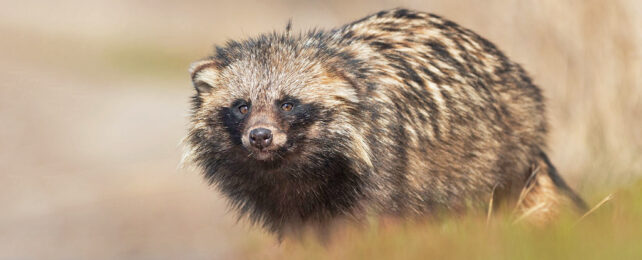The virus behind COVID-19 appears to have first leapt to humans from captive wildlife at the Huanan seafood market in Wuhan, and now a new study identifies specific animals that likely carried the virus.
The new analysis – of metagenomic RNA data collected shortly after the market was shut down – also supports accumulating evidence for SARS-CoV-2's origin.
The first signs of trouble were in Wuhan, the capital of China's Hubei province, in late 2019. Along with the now-defunct seafood and animal market, the city is home to the Wuhan Institute of Virology (WIV), where scientists have studied coronaviruses.
While research shows SARS-CoV-2 wasn't made in a lab, its emergence in the same city as the WIV has raised suspicions and inspired widespread speculation. Even if it evolved naturally, for example, a popular theory suggests the virus could have escaped after researchers collected it from the wild.
There is scant evidence of a lab leak, however, and many virologists say it's far likelier the virus jumped to humans from one of many other mammals at the Huanan market, where conditions were ripe for a zoonotic spillover.
Hoping for clarity, an international team of researchers conducted the new analysis of data collected by the Chinese Center for Disease Control and Prevention (CDC) in early 2020.
"This is one of the most important datasets that exists on the origin of the COVID-19 pandemic," says the study's senior author, evolutionary biologist Florence Débarre of the French National Centre for Scientific Research (CNRS).
"We're extremely grateful that the data exist and were shared."
Investigators from the Chinese CDC entered the Huanan market on New Year's Day 2020, hours after the market closed due to COVID. Although the animals were already gone, the team took samples from the environment.
After initially swabbing surfaces in stalls where animals were held, the team returned days later to swab more stalls, cages, and carts, and to collect samples from drains and sewers.
They also used metatranscriptomic sequencing to reveal every RNA sequence from every organism detected in the samples, along with some DNA, and compared these to samples from early cases of SARS-CoV-2 up until 14 February 2020.

The Chinese CDC team published their findings in Nature in 2023. All together, they had over 800 samples, and while they didn't specify which animals were potential intermediate hosts for SARS-CoV-2, they did share their sequencing data on open-access repositories.
That enabled the new analysis, which identifies animal species in the samples by genotyping their mitochondrial genomes, the authors explain.
Débarre, along with first author and microbiologist Alexander Crits-Christoph and their colleagues, found evidence of the virus in stalls that held animals, including raccoon dogs and civets. Some samples even had genetic material from animals and SARS-CoV-2 together on one swab.
"Many of the key animal species had been cleared out before the Chinese CDC teams arrived, so we can't have direct proof that the animals were infected," Débarre says.
"We are seeing the DNA and RNA ghosts of these animals in the environmental samples, and some are in stalls where SARS-CoV-2 was found, too," she adds. "This is what you would expect under a scenario in which there were infected animals in the market."
The study also included an evolutionary analysis of viral genomes from COVID's early days, seeking likely forebears of the virus that launched the pandemic. The results suggest few if any humans were infected before market-related outbreaks.
"In this paper, we show that the sequences linked to the market are consistent with a market emergence," Débarre says. "The main diversity of SARS-CoV-2 was in the market from the very beginning."
Based on their findings, the authors created a short list of animal species at the market that most likely served as intermediate hosts.
The common raccoon dog (Nyctereutes procyonoides) was the most genetically abundant animal in the samples, they report, but genetic material from the masked palm civet (Paguma larvata) also turned up in a stall with RNA from SARS-CoV-2.
Both species were linked with the original SARS outbreak, the researchers note, and common raccoon dogs have a known susceptibility to SARS-CoV-2.
"These are the same sorts of animals that we know facilitated the original SARS coronavirus jumping into humans in 2002," says ecologist Michael Worobey of the University of Arizona.
"This is the most risky thing we can do – take wild animals that are teeming with viruses and then play with fire by bringing them into contact with humans living in the heart of big cities, whose population densities make it easy for these viruses to take hold," Worobey adds.
While the new study doesn't prove any animals were infected with SARS-CoV-2, it does offer clues that could aid future investigations, along with further establishing the Huanan market as COVID's launchpad.
"This paper adds another layer to the accumulating evidence that all points to the same scenario: that infected animals were introduced into the market in mid- to late November 2019, which sparked the pandemic," says evolutionary biologist Kristian Andersen of the Scripps Research Institute in the US.
That's relevant not only for retrospective studies of COVID's origin, but also for preventing future pandemics.
"Since the pandemic started more than four years ago, although there has been an increased focus on lab safety, not much has been done to decrease the chance of a zoonotic scenario like this happening again," Worobey says.
The study was published in Cell.
